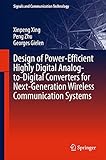Design of Power-Efficient Highly Digital Analog-to-Digital Converters for Next-Generation Wireless Communication Systems [electronic resource] / by Xinpeng Xing, Peng Zhu, Georges Gielen.
By: Xing, Xinpeng [author.] .
.
Contributor(s): Zhu, Peng [author.] | Gielen, Georges [author.]
| Gielen, Georges [author.] | SpringerLink (Online service)
| SpringerLink (Online service) .
.
Material type:  BookSeries: Signals and Communication Technology: Publisher: Cham : Springer International Publishing : Imprint: Springer, 2018Edition: 1st ed. 2018.Description: XXVII, 181 p. 148 illus., 98 illus. in color. online resource.Content type: text Media type: computer Carrier type: online resourceISBN: 9783319665658.Subject(s): Electronic circuits
BookSeries: Signals and Communication Technology: Publisher: Cham : Springer International Publishing : Imprint: Springer, 2018Edition: 1st ed. 2018.Description: XXVII, 181 p. 148 illus., 98 illus. in color. online resource.Content type: text Media type: computer Carrier type: online resourceISBN: 9783319665658.Subject(s): Electronic circuitsIntroduction -- A–D Converters and Their Applications -- Continuous-Time Delta–Sigma ADCs -- VCO-Based ADCs -- 40MHz-BW 12-bit Low-Power CT Delta–Sigma ADCs in 90nm CMOS -- Two-step Open-Loop VCO-Based ADC -- VCO-based 0-2 Delta–Sigma MASH ADCs -- Fully-VCO-based High-order Delta–Sigma ADCs -- Conclusions.
This book discusses both architecture- and circuit-level design aspects of voltage-controlled-oscillator (VCO)-based analog-to-digital converters (ADCs), especially focusing on mitigation of VCO nonlinearity and the improvement of power efficiency. It shows readers how to develop power-efficient complementary-metal-oxide-semiconductor (CMOS) ADCs for applications such as LTE, 802.11n, and VDSL2+. The material covered can also be applied to other specifications and technologies. Design of Power-Efficient Highly Digital Analog-to-Digital Converters for Next-Generation Wireless Communication Systems begins with a general introduction to the applications of an ADC in communications systems and the basic concepts of VCO-based ADCs. The text addresses a wide range of converter architectures including open- and closed-loop technologies. Special attention is paid to the replacement of power-hungry analog blocks with VCO-based circuits and to the mitigation of VCO nonline arity. Various MATLAB®/Simulink® models are provided for important circuit nonidealities, allowing designers and researchers to determine the required specifications for the different building blocks that form the systematic integrated-circuit design procedure. Five different VCO-based ADC design examples are presented, introducing innovations at both architecture and circuit levels. Of these designs, the best power efficiency of a high-bandwidth oversampling ADC is achieved in a 40 nm CMOS demonstration. This book is essential reading material for engineers and researchers working on low-power-analog and mixed-signal design and may be used by instructors teaching advanced courses on the subject. It provides a clear overview and comparison of VCO-based ADC architectures and gives the reader insight into the most important circuit imperfections.


There are no comments for this item.